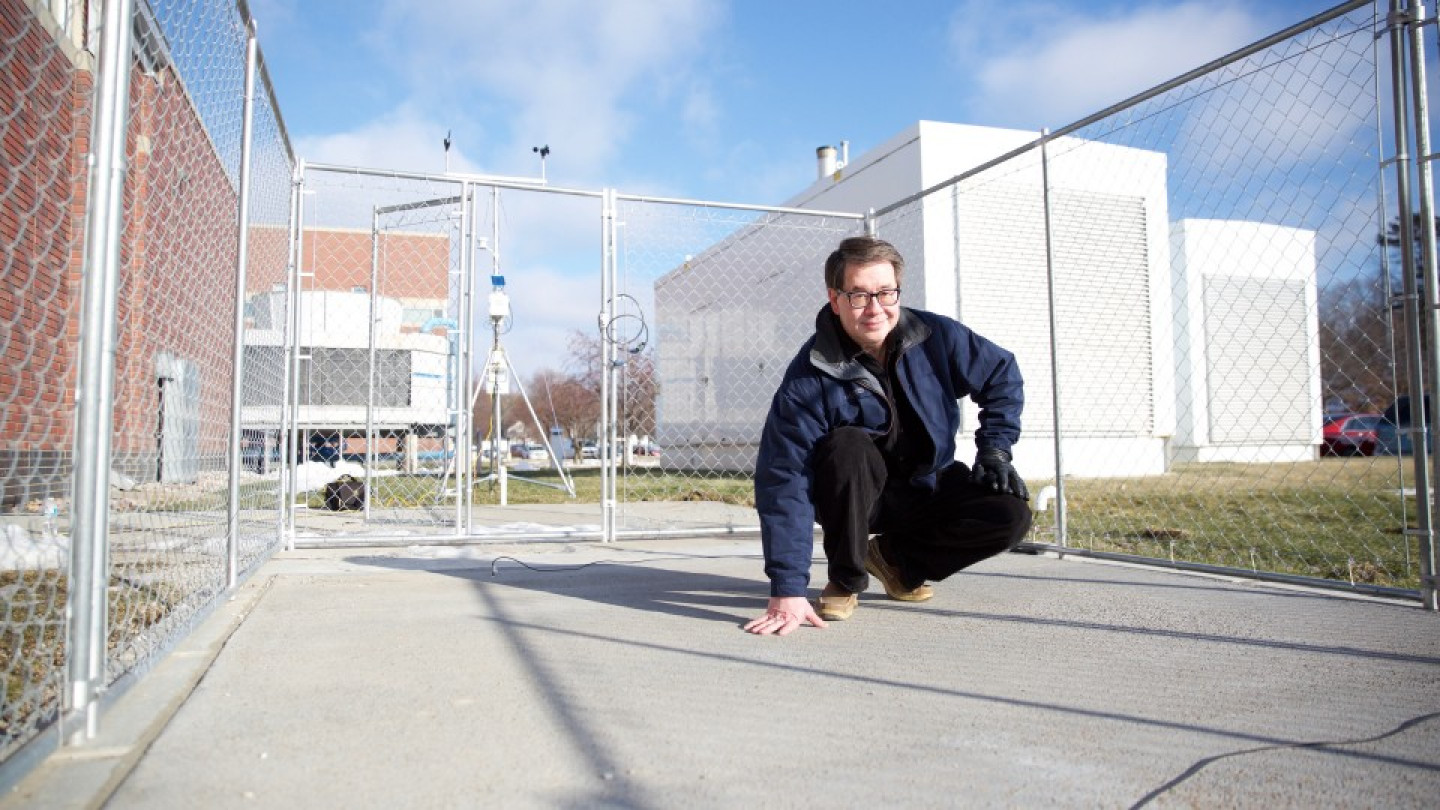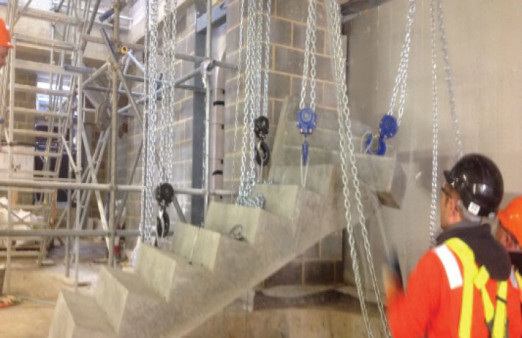Research led by Professor Christopher Y Tuan at the University of Nebraska-Lincoln is tackling the issue of de-icing concrete. A conductive concrete innovation adds steel shavings and carbon particles to a standard concrete mixture, which conducts enough electricity to melt ice and snow in the worst winter storms, while remaining safe to the touch.
There has been remarkable advancement made in cementitious materials research to improve concrete strength and durability. For instance, the compressive strength of concrete has approximately tripled in the past 40 years. Concrete production has become more a science than an art for various structural applications. Engineers nowadays are very familiar with the terms such as high-performance, ultra-high-performance, self-compacting, pervious, decorative concrete and so on.
So, what is conductive concrete (CC)? Conductive concrete may be defined as a concrete mixture containing a certain amount of electrically conductive components in a regular concrete, designed to enable conduction of electricity. Regular concrete is not electrically conductive. Carbon and steel, in the form of particles and fibres have been used for the conductive components. Geological materials, such as iron ore, may also be used for aggregates in concrete to enhance conductivity. Due to its electrical resistance, CC can generate enough heat to prevent ice formation on a paved surface when connected to a power source.
There are many applications for conductive concrete, roadway de-icing, electrical grounding, radiant heating, steel reinforcement corrosion protection, structural health monitoring, electromagnetic wave shielding, to name a few. Some of these applications are passive, such as electrical grounding and electromagnetic wave shielding, in which the conductive concrete is not energised.
Heated deck of Roca Spur Bridge
The heated deck of Roca Spur Bridge is the first implementation in the world using conductive concrete for de-icing. The Roca Spur Bridge is a 150ft long × 36ft wide, threespan highway bridge over the Salt Creek at Roca, Nebraska, located near Highway 77 South. The bridge construction was completed in November 2002, and the heated deck control system was completed in March 2003. The technology provides an environmentally friendly solution to the looming crisis of water supply contamination by road salts, especially from bridge run-off over streams and rivers. It is also beneficial to rural communities and residents that are at a great distance from plow truck dispatch centers.
The de-icing performance of the heated deck was monitored during 2003–2008 by the Nebraska Department of Roads. Powered by a 3-phase, 208V AC source, the de-icing system performed exceedingly well, as evidenced by Figure 1. The corresponding temperature timehistories during the de-icing operation are presented in Figure 2. A summary of the performance data during the five-year study is given in Table 1. On the average, the energy cost for the heated deck was about $85/day during a major winter storm.

Fig 1: Heated deck of the Roca Spur Bridge

Fig 2: Average deck temperature vs air temperature
This de-icing technology can be readily implemented at accident-prone locations such as bridge overpasses, exit ramps, airfield runways, street intersections, parking garages, sidewalks, and driveways.
Conductive concrete for pavement de-icing has not been widespread due to regulatory restrictions. The National Electric Code (NEC) in its current version does not have provisions applicable to conductive concrete, but treats CC as an electrical conductor and presumes electrical shock hazards to a human body. The reason that CC is safe to the touch is simply because the electrical resistance of a human body is higher than that of CC. The safe threshold of electrical current to human body is 5 milliamps (mA). It takes time for an emerging technology to be approved by the regulatory officials before the technology can be made available to the general public. For instance, it took more than 25 years for microwave ovens to become popular in the American households.
NEC also stipulates that if the applied voltage to an electrical device is under 48V, such as the lighting devices commonly used for landscaping, no inspection is necessary. So, for those enthusiastic homeowners who would like to try out the CC technology to heat the driveway and sidewalk, you would need a transformer (from 110 to 48V) and an electrician to complete the electrical work.
Driveway de-icing under 48V
A heated driveway section of 30ft long × 7ft wide was constructed in a subdivision in Omaha, Nebraska, in July 2010, using 48V AC. Prior to installation, the entryway was always covered with thick ice in winter, which made it treacherous driving into the garage. The de-icing performance of the heated section has been excellent, as evidenced in Figure 3. The energy cost was about $3 per day and brought a smile to the owner’s face, who preferred flipping a switch to shovelling snow and chopping ice. Unlike the hydronic systems pumping hot water through embedded pipelines that must stay on at all time, you turn the switch off when there is no snowstorm.
Heated Airport Tarmac
The Federal Aviation Administration (FAA) has been searching for a cost-effective and durable heated pavement technology for large-scale implementation for snow and ice removal at main hubs. The tarmac around the gates at a terminal is always congested due to activities by the ground crew, unloading and loading the passengers, luggage, waste disposal, fuelling, meals, and other services. Snow and ice accumulation on the tarmac slows down these operations and causes delay of flights.
This project is funded by the US Federal Aviation Administration (FAA) to develop a costeffective conductive concrete that yields the lowest cost, while providing adequate mechanical strength, long-term durability, and de-icing performance. The scope of work includes selecting conductive materials, conducting mechanical and accelerated durability tests on CC test specimens, and evaluating the heating characteristics of the various mix designs in a laboratory freezer. The CC developed has met or exceeded the required mechanical strengths for highway and airfield concrete pavements. It also showed good durability and should provide an anticipated service life of 25–30 years.
A 10ft × 20ft, 6-inch thick test pad was constructed outdoors using the most cost-effective mix developed, and it was energised during the 2015–16 snowstorms. Figure 4 shows the excellent de-icing performance of the test pad. The operating costs range from $0.02 to $0.04/ft2 (see Table 2) and is maintenance free. The conductive concrete de-icing technology is far superior to its peer technologies. The cost of the concrete is approximately $300/yd3. This project demonstrates that CC technology is affordable for large-scale implementation. The project will run through September 2016. If the FAA is satisfied with the findings from this study, the Administration would implement a 150 × 40ft test tarmac section at its Technical Center at the Atlantic City International Airport, New Jersey.

Figure 4: Heated test pad after the snowstorm on 27–29 December 2015.
Although the cost of CC is about twice that of regular concrete, there is tremendous life-cycle cost savings compared to the use of regular concrete with other de-icing means. The additional cost is justified by its superior strength (about 1.5 times that of regular concrete), its low operating cost and being maintenance free. Conductive concrete also offers intangible benefits such as saving time, saving money and saving lives.
The conductive concrete has been developed with the assistance of Dr Lim Nguyen, professor of electrical and computer engineering at UNL. The FAA is currently funding the heated pavement research, which has also received past support from the Nebraska Department of Roads.
Table 1 – Deicing performance of Roca Bridge heated deck
| Storm date | Snow (in.) |
Air temp. (°F) |
Wind (mph) |
Energy (kWh) |
Unit cost* ($/ft2) |
Peak power density (W/ft2) |
| 24–25 Dec 2015 | 7.0 | 23.4 | 8.5 | 45.9 | 0.021 | 15.5 |
| 27–28 Dec 2015 | 4.2 | 13.6 | 18.6 | 69.8 | 0.031 | 14.4 |
| 25 Jan 2016 | 4.0 | 25.2 | 16.5 | 73.4 | 0.032 | 13.0 |
| 2–3 Feb 2016 | 4.9 | 12.9 | 12.4 | 84.9 | 0.037 | 11.8 |
*Utility rate in Omaha, Nebraska: $0.088/kWh
Table 2 – Summary of performance data of the test pad
| Storm date | Snow (in.) |
Air temp. (°F) |
Wind (mph) |
Energy (kWh) |
Unit cost* ($/ft2) |
Peak power density (W/ft2) |
| 24–25 Dec 2015 | 7.0 | 23.4 | 8.5 | 45.9 | 0.021 | 15.5 |
| 27–28 Dec 2015 | 4.2 | 13.6 | 18.6 | 69.8 | 0.031 | 14.4 |
| 25 Jan 2016 | 4.0 | 25.2 | 16.5 | 73.4 | 0.032 | 13.0 |
| 2–3 Feb 2016 | 4.9 | 12.9 | 12.4 | 84.9 | 0.037 | 11.8 |
*Utility rate in Omaha, Nebraska: $0.088/kWh




